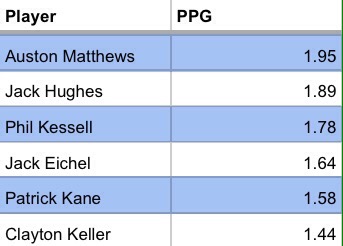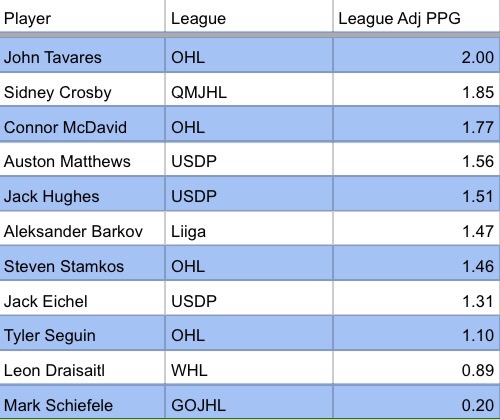Every year, there’s one draft-eligible prospect that enters the season as the projected first overall pick in the draft that will occur the following June. Most of the time, that prospect stays on course and actually ends up being the first overall pick. On less frequent occasions, that player is overtaken, like what happened in 2017 which saw Nico Hischier overtake Nolan Patrick, who entered the campaign as the consensus number one.
In years past, that player has been the aforementioned Patrick, Auston Matthews, and Connor McDavid. This year, it’s Jack Hughes, and although things can change, it appears extremely unlikely that he isn’t in the same position next June. That’s not because of a lack of depth behind him; this is undoubtedly not a class without a “true #1 pick” — in fact, I think consensus #2 prospect Kaapo Kaako could pass as an excellent first overall selection any day of the week, but simply because Hughes is just at another level.
He’s been described as a “super-prospect”, and that isn’t hyperbole. Hughes is an excellent hockey player, but how does he compare to similarly excellent prospects of years past?
First off, let’s compare some of the numbers that have come as a result of the time in which current NHL’ers have previously spent with the USNTDP, like Hughes:
Auston Matthews
One of the best comparisons for Hughes would be Toronto Maple Leafs star Auston Matthews. Like Matthews, Hughes played for the USNTDP U18 team in his D-1 year, and like Matthews, Hughes put up statistics for that team that bordered on insane despite being a year younger than the competition.
In 36 games with the U18s, Hughes put up 68 points, which translates to 1.88 PPG. That’s quite the mark, but how does it stack up to Matthews?
Matthews played 60 games with the U18s in his draft-minus-one season, totalling 117 points. That’s an excellent total, good for 1.95 PPG. That’s superior to what Hughes put up, and Matthews did it over a larger sample size as well.
It appears that Hughes is slightly below Matthews, but that shouldn’t be a knock on the draft-eligible phenom. Matthews is already an NHL star in just his second season. He put up over a point per game last year, and he’s only getting started on the age curve.
Hughes’ production for the U18s equates to 96% of Matthews — if his NHL production ends up being 96% of Matthews’, we’re talking an 80+ point player.

Phil Kessel
Kessel is a winger, not a pivot, so this comparison isn’t ideal, but the Penguins star is one of the best players the program has ever produced. Kessel has enjoyed an illustrious 12 year career, totalling 741 points in 914 games. He’s been good for about 65 points a season throughout his career, and set a career high in points this season with 92 recorded.
Hughes outproduced Kessel in his draft-minus-one season by 0.11 PPG, which equates to about nine points over 82 games played.

Jack Eichel
Let’s move on to another American star out of the USNTDP. Before heading to Boston College for his draft year, Jack Eichel also suited up the U18 team while a year younger than the competition. His 1.64 PPG, although impressive, isn’t quite Hughes’ 1.88.
Eichel has been good for 55-65 points so far throughout his three year career, and it’s safe to expect that to increase as Eichel ages, growing closer to his prime. If these statistics indicate anything, Hughes should be good for a total comfortably above that.

Patrick Kane
Kane could be the best player to ever come of the USNTDP. He’s the only legitimate superstar on this list, although Matthews could challenge, and the fact that Hughes ranked higher on the list than Kane is extremely promising. Kane has cleared a point per game over his entire career, with 828 points in 822 games. If Hughes ends up at a similar level, he’d be a star as well.

Clayton Keller
Keller didn’t suit up for the U18s as often as the other prospects on this list, only playing 16 games, so we’ll bring up time spent with the U17s as well. The bigger the sample size, the better. With the U18s, Keller had 23 points, for 1.44 PPG. That’s comfortably below the total that Hughes put up. Going to the U17s now, Keller only had 1.3 PPG. Meanwhile, Hughes was scoring at a 2.0 PPG pace.
As is fairly obvious from the gap between their numbers, Hughes would appear to be a significantly better prospect than Keller. For reference, Keller had 65 points this season, his first in the NHL, as a 19-year-old out of Chesterfield, Missouri.
Now, we’ll expand our scope past just the USNTDP using League Adjusted PPG, which adjusts production for league strength.
For this exercise, I’m breaking out @manny_hockey’s recently released adjustment factors.
1. NHL 1.0000
2. KHL 0.7461
3. Russia 0.7204
4. WHA 0.6963
5. SHL 0.6375
6. Czech 0.5563
7. Liiga 0.4696
8. NLA 0.4632
9. Czech Q 0.4517
10. Kvalserien SHL 0.4430
11. AHL 0.4241
12. Germany 0.3633
13. IHL 0.3626
14. Russia2 0.3575
15. VHL 0.3419
16. SM-sarja 0.3343
17. DEL 0.2949— Manny (@mannyelk) July 3, 2018
Hughes is sandwiched between Auston Matthews and a group containing Aleksander Barkov of the Florida Panthers, Steven Stamkos of the Tampa Bay Lightning as well as Jack Eichel of the Buffalo Sabres.
As already mentioned, Matthews is a budding superstar that passed a point per game in just his second NHL season. We also touched on Jack Eichel, another up and coming star, who appears on track to reach the point per game mark himself one day.

Aleksander Barkov
Barkov continues to be one of the more underrated players in the NHL, despite three straight 50+ point seasons, including a 78 point campaign this season, which saw him play 79 games. He arguably deserved the Selke this year and is already an NHL star, although he may not get the recognition of one.
Jack Hughes has a slight edge on Barkov in terms of League Adjusted PPG. While I wouldn’t expect the same kind of two-way game from Hughes, a higher offensive output is very much possible.

Steven Stamkos
One of the premier snipers in the NHL, Stamkos hit the 60 goal plateau in 2011-12. While he hasn’t repeated that mark since, he was on pace for 50 and 55 in a pair of shortened seasons in 2012-13 and 2013-14. His production has dropped off since his prime, when he was good for more than a point per game, but he’s still an 80 point centre.
Hughes is on track to best that.
It’s extremely promising that Hughes is ahead of these two players at this point in his development. While it’s way too early to guarantee anything, it’s entirely possible that Hughes could become a better player than these two.

It’s not only statistics that back this narrative. After a beat was skipped last year, a franchise centre is back at the top of the draft and it looks like a good one. Hughes is an excellent skater, moving well both straight forward and backward as well as laterally. This skating ability allows him to cut through the defence, attacking through the seams.
He can threaten with his playmaking ability; his vision is elite and he can thread seemingly impossible passes as well. He has the soft hands to be deadly in tight and is easily capable of potting anything in that range. He’s essentially the full package, however, some might find his size to be a concern. At 5’10, 161 lbs, he’s still built fairly well but he doesn’t have the size that some teams like in their top line centres. If I had any doubts about his stature, I would have brought it up much earlier — I think it’s very unlikely that his size holds him back to any extent; he’s simply too good for that.
At this point, a realistic expectation for Hughes is somewhere between Auston Matthews and Jack Eichel. Between a 1.02 PPG player and a 0.96 PPG player is a very good place to be and it suggests that Hughes could be good for about a point per game throughout his career, potentially more. That’s enough for superstar status.

